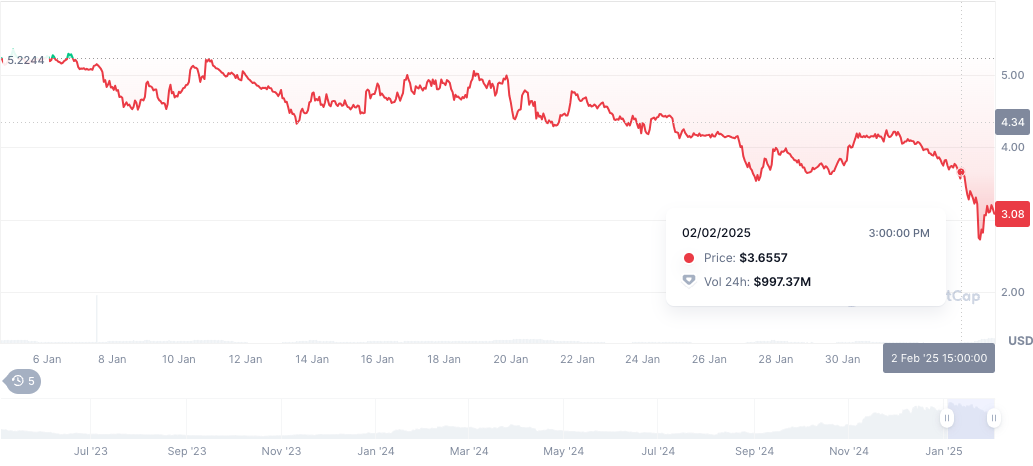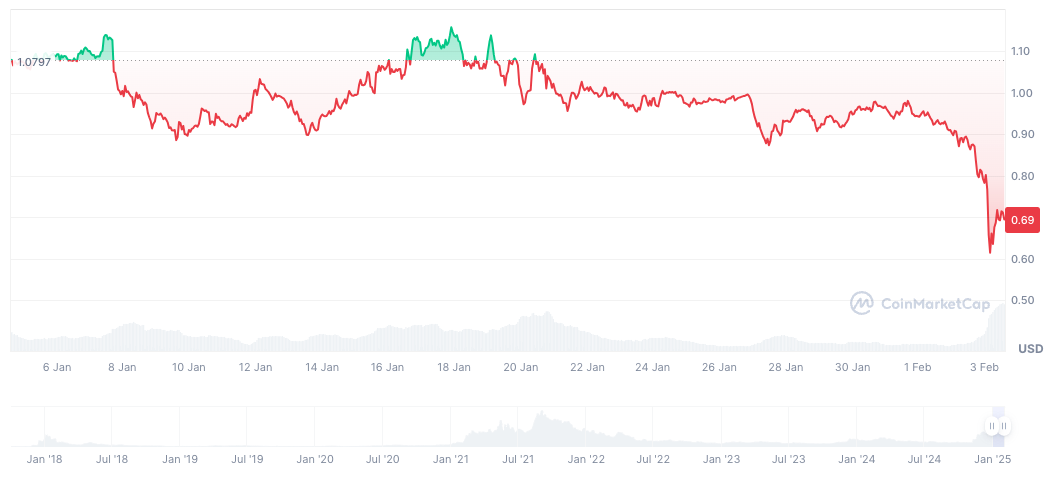The cryptocurrency market confronts heightened volatility, with SUI price plummeting 18% to $2.87 and Cardano falling 25% to $0.65 over recent weeks. Analysts link SUI’s decline to a scheduled token unlock event releasing $51 million in assets, while Cardano’s downturn persists despite growing speculation around a potential ADA ETF.
Regulatory discussions about leveraged ETF products and macroeconomic pressures have intensified market unpredictability, driving traders toward AI-enhanced platforms. Innovations like real-time data processing and adaptive trading algorithms are gaining traction, offering strategies to navigate SUI price swings and ADA ETF-related risks. As traditional assets falter, these technologies highlight crypto’s evolving role in modern finance.
SUI Price Volatility Reflects Broader Market Sentiment Shifts
Recent market activity highlights significant pressure on the SUI price, which dropped to $3 following a 22% decline over nine days and a 30% decline in 30 days. Analysts attribute this downturn to broader bearish trends and an upcoming token unlock event releasing 64 million SUI tokens worth $51 million. Historical patterns suggest such unlocks often trigger short-term sell-offs, though the SUI price could stabilize if critical support at $3.69 holds, which did not.
VanEck’s analysis projects a potential SUI price rebound to $16 by late 2025, contingent on network adoption and ecosystem growth. The downward trajectory mirrors challenges across altcoins, with Cardano also struggling despite rising ADA ETF optimism. While SUI price volatility underscores market fragility, AI-driven platforms mitigate risks through adaptive trading mechanisms, positioning themselves as potential stabilizers in uncertain conditions.
Cardano ETF Speculations Reveal Institutional Crypto Adoption Challenges
Cardano’s 35% monthly decline contrasts sharply with growing ADA ETF speculation, fueled by Tuttle Capital’s application for a 2x leveraged product. Approval could mirror Bitcoin’s 50% post-ETF surge, potentially lifting Cardano toward $1.30 resistance levels. However, skepticism persists as synthetic ETF structures may prioritize speculation over ecosystem growth, risking short-term ADA price swings without fundamental improvements.
Polymarket data shows 54% approval odds for the ADA ETF, reflecting cautious optimism. Analysts note Cardano’s Midnight zk-rollup launch and BitcoinOS integration could strengthen its case, though the current ADA price action remains in the range bound at $0.95. For investors, the ADA ETF narrative emphasizes crypto’s institutionalization hurdles, where regulatory milestones often precede volatile price reactions rather than sustainable growth.
Meanwhile, leveraged ETF mechanisms relying on synthetic exposure risk decoupling price action from Cardano’s ecosystem health. While Tuttle Capital’s proposal could amplify daily trading volumes, it bypasses network participation metrics like developer activity or decentralized application growth.
This divergence is evident in ADA’s current $0.70 valuation, which remains 45% below January highs despite ETF optimism, underscoring the challenge of translating financial products into sustainable blockchain adoption. Analysts caution that without parallel advancements in real-world utility, ADA ETF-driven gains may prove ephemeral compared to projects integrating AI and institutional infrastructure.
AI-Powered Trading Systems Redefine Market Stability for 2025
As traditional assets falter, AI-enhanced platforms like IntelMarkets showcase how machine learning addresses crypto volatility. Their Intelli-M™ bots analyze 100,000+ data points to automate strategies, adapting to real-time SUI price fluctuations and ADA ETF developments. This infrastructure processed $8 million in presale funding, leveraging dual-chain Ethereum/Solana compatibility to optimize transaction speeds during market turbulence.
Studies indicate that AI-driven trading reduces execution errors by 80% while improving portfolio returns by 30%, a critical advantage as SUI price and Cardano face macroeconomic pressures. IntelMarkets’ 1000x leverage and sentiment analysis tools further empower traders navigating ADA ETF uncertainties, positioning INTL as a top crypto to invest in for exposure to AI-DeFi convergence.
Conclusion
Recent market shifts underscore the challenges facing altcoins, with SUI price testing critical support levels near $2.87 and Cardano grappling with mixed sentiment around ADA ETF prospects. While regulatory progress could reshape valuations for both assets, AI-driven platforms like IntelMarkets demonstrate how real-time analytics and automated trading strategies counterbalance uncertainty.
Technologies blending machine learning with blockchain infrastructure, such as Intelli-M™ bots and dual-chain compatibility, are vital for managing risks tied to SUI price volatility and ADA ETF developments. As traders navigate these dynamics, platforms offering adaptive tools—from 1000x leverage to sentiment analysis—position themselves as essential for capitalizing on 2025’s evolving opportunities. Investors eyeing stability may prioritize projects combining AI innovation with resilient ecosystems to weather ongoing market turbulence.
Learn more:
Join The IntelMarkets Community































